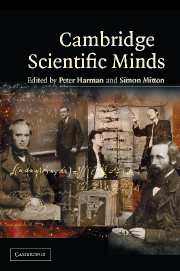Book contents
- Frontmatter
- Contents
- Foreword
- Introduction
- 1 William Gilbert
- 2 William Harvey
- 3 Isaac Newton: Creator of the Cambridge scientific tradition
- 4 William Whewell: A Cambridge historian and philosopher of science
- 5 Adam Sedgwick: A confident mind in turmoil
- 6 Charles Babbage: Science and reform
- 7 Charles Darwin
- 8 Stokes and Kelvin, Cambridge and Glasgow, light and heat
- 9 James Clerk Maxwell
- 10 The duo from Trinity: A.N. Whitehead and Bertrand Russell on the foundations of mathematics, 1895–1925
- 11 Thomson, Rutherford and atomic physics at the Cavendish
- 12 Hopkins and biochemistry
- 13 Charles Sherrington, E.D. Adrian, and Henry Dale: The Cambridge Physiological Laboratory and the physiology of the nervous system
- 14 Hardy and Littlewood
- 15 Arthur Stanley Eddington
- 16 Paul Dirac: A quantum genius
- 17 Alan Turing
- 18 Francis Crick and James Watson
- 19 Mary Cartwright
- 20 Joseph Needham
- 21 Molecular biology in Cambridge
- 22 The discovery of pulsars – prelude and aftermath
- 23 Stephen W. Hawking
22 - The discovery of pulsars – prelude and aftermath
Published online by Cambridge University Press: 05 June 2014
- Frontmatter
- Contents
- Foreword
- Introduction
- 1 William Gilbert
- 2 William Harvey
- 3 Isaac Newton: Creator of the Cambridge scientific tradition
- 4 William Whewell: A Cambridge historian and philosopher of science
- 5 Adam Sedgwick: A confident mind in turmoil
- 6 Charles Babbage: Science and reform
- 7 Charles Darwin
- 8 Stokes and Kelvin, Cambridge and Glasgow, light and heat
- 9 James Clerk Maxwell
- 10 The duo from Trinity: A.N. Whitehead and Bertrand Russell on the foundations of mathematics, 1895–1925
- 11 Thomson, Rutherford and atomic physics at the Cavendish
- 12 Hopkins and biochemistry
- 13 Charles Sherrington, E.D. Adrian, and Henry Dale: The Cambridge Physiological Laboratory and the physiology of the nervous system
- 14 Hardy and Littlewood
- 15 Arthur Stanley Eddington
- 16 Paul Dirac: A quantum genius
- 17 Alan Turing
- 18 Francis Crick and James Watson
- 19 Mary Cartwright
- 20 Joseph Needham
- 21 Molecular biology in Cambridge
- 22 The discovery of pulsars – prelude and aftermath
- 23 Stephen W. Hawking
Summary
The early history of the Cavendish Laboratory is best known for ground-breaking work in the study of atomic structure, but the birth of long-distance radio communication also stimulated research on the properties of the upper atmosphere which enabled such propagation to occur. Begun by E.V. Appleton, who was later awarded the Nobel Prize in 1947 for his discovery of the ionosphere, radiophysics at the Cavendish was continued until 1939 by J.A. Ratcliffe and it was he who initiated radioastronomy in 1945. What triggered Ratcliffe's interest was an occasion in February 1942 when radar stations along the south coast were blinded by radio interference, initially thought to be jamming by enemy action, but later found to be radiation emitted by the sun when a large sunspot was present on the disk. Anxious to regenerate radiophysics at the end of the war, Ratcliffe attracted M. Ryle, a wartime colleague, back to the Cavendish and suggested that investigation of this new solar phenomenon might be an interesting project.
By 1946 Ryle had set up a primitive radio telescope and discovered that the sun was a continuous emitter of radio waves, in addition to the more intense outbursts associated with sunspots. More importantly, however, he demonstrated the existence of other celestial radio emitters, then called radio stars, and radioastronomy in Cambridge had begun. I joined Ryle's group in 1948 and this essay outlines the course of my personal research, leading to the discovery of pulsars in 1967, which has been ranked as one of the major astronomical breakthroughs of the past fifty years.
- Type
- Chapter
- Information
- Cambridge Scientific Minds , pp. 325 - 337Publisher: Cambridge University PressPrint publication year: 2002



